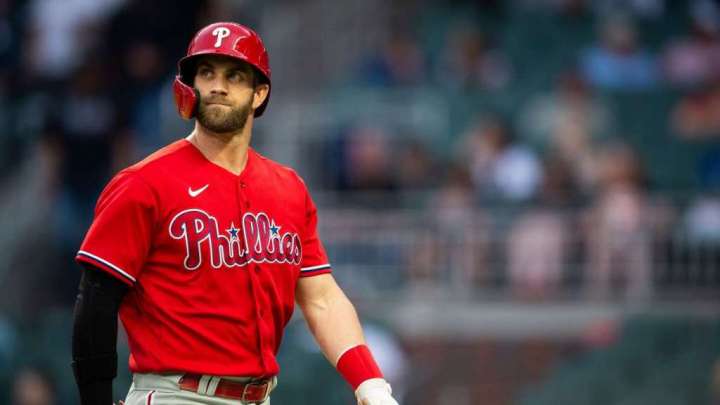There was both curiosity and excitement when MLB announced in March that the designated hitter rule would expand to the National League, eliminating the need for pitchers to hit for themselves. The justification, of course, was simple: Pitchers are not very good at hitting (and getting worse), and the sport would benefit from fewer automatic outs in lineups.
Baseball’s universal DH is two months old. Here are four things we’ve learned.

So two months into the season, how is the new rule working? Not surprisingly, the National League’s designated hitters have outperformed pitchers at the plate, but lineups are still lagging behind their historical peers by a wide margin, resulting in the NL’s lowest combined on-base-plus-slugging rate since 2014. Small-ball elements of the game, such as bunts and pinch hitters, are declining and on a path to extinction. Bryce Harper is showing how the new rule can help keep injured offensive stars in the lineup, while the San Diego Padres are flailing to fill the role with quality at-bats.
There is still plenty of time in this season for the dynamics to shift, and it remains to be seen whether NL roster construction will change with a full offseason to adapt. Still, here are some early takeaways after two months with the universal designated hitter as a permanent part of the sport.
Offensive numbers didn’t shoot up
Designated hitters in the NL, as a group, were batting .241 with a .320 on-base percentage and .402 slugging percentage through June 1. Perhaps surprisingly, that’s better than their counterparts in the American League, which has had the designated hitter rule since 1973. Designated hitters in the AL were batting .228 with a .305 on-base percentage and .381 slugging percentage through June 1, giving them an inferior overall OPS (.686).
Pitchers, by comparison, batted .108 with a .285 OPS last season. But while the universal DH clearly brought offensive improvement to one lineup slot, it perhaps didn’t have the sweeping impact many expected. The collective OPS in the NL has actually declined this season. Why? Batted balls aren’t traveling as far when solid contact is made this season — the ball is traveling four fewer feet than last year even off barrels — and more pitches out of the zone are drawing swings. There have also been fewer four-seam fastballs thrown this season and more sinkers and change-ups, which has reduced the effectiveness of hitters across the board.
These three teams have gotten the most production out of their DHs
The Philadelphia Phillies, by often using a two-time MVP as their DH, are getting the most from the position. Harper, thrust into the role because of an elbow injury that has prevented him from playing the field, was hitting .336 with 10 home runs, 32 RBI and a .940 OPS through June 1. Overall, Philadelphia’s designated hitters are creating runs at a rate 56 percent higher than the MLB average after adjusting for league and park effects. Only the Boston Red Sox are getting better production from their designated hitters this season.
The Miami Marlins and Pittsburgh Pirates are tied for second-most NL run creation from the DH slot; the designated hitters for both teams are creating runs at a rate 17 percent higher than the major league average.
The Padres are struggling with their designated hitters
The San Diego Padres, on the other hand, are seeing their designated hitters bat .177 with a .531 OPS this season, making them by far the laggards of the NL and the worst collection of designated hitters in the majors. They are also producing runs at a rate 41 percent lower than the MLB average after adjusting for league and park effects. That’s no small issue for a team with serious postseason aspirations.
The number of bunt attempts and pinch hitters has declined significantly
Despite the relatively lackluster performances by designated hitters, bunts and pinch hitters have all but vanished. In 1974, bunts accounted for a little more than 2 percent of all at-bats. This year — as in 2020, a pandemic-shortened season in which the universal DH rule was also used — the rate of bunts is down to less than 1 percent. Pinch hitters, meanwhile, took anywhere from 1.1 and 1.3 at-bats per game in every season since 1974 — except 2020 and 2022. In those years with the universal designated hitter, pinch hitters accounted for less than one at-bat per game.
As the universal designated hitter matures in the NL, we might expect offensive production to improve, but how much remains open to debate. If anything, the AL should see more offensive improvement than the NL, based on results thus far compared with expectations. For example, AL designated hitters should have a .412 slugging rate based on the launch angles and exit velocities of each ball put in play this season, but they instead have a slugging rate of .385. The NL designated hitters have a slugging percentage of .401 compared with an expected rate of .414.
But to truly see meaningful change in baseball’s offensive numbers, we might have to wait for some of the game’s other potential changes, such as the implementation of a pitch clock, limits on defensive shifting and larger bases.






